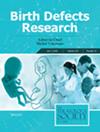Update on the impact of voluntary folic acid fortification of corn masa flour on red blood cell folate concentrations—National Health and Nutrition Examination Survey, 2011–March 2020
Abstract
Background
Folic acid is a micronutrient that is effective at preventing neural tube defects (NTDs). In 2016, the FDA authorized the voluntary fortification of corn masa flour (CMF) with folic acid to reduce disparities in NTDs among infants of women who do not regularly consume other fortified cereal grains, in particular Hispanic women of reproductive age (WRA).
Methods
We analyzed data from the National Health and Nutrition Examination Survey (NHANES) from 2011 to March 2020 assessing the impact of voluntary fortification of CMF on the folate status of Hispanic WRA. We analyzed folic acid usual intake and red blood cell (RBC) folate concentrations among non-pregnant, non-lactating Hispanic WRA, comparing pre-fortification (2011–2016) to post-fortification (2017–March 2020) data. RBC folate concentrations were used to create model-based estimation of NTD rates.
Results
The proportion of Hispanic WRA with folic acid usual intakes <400 μg/d did not change (2011–2016: 86.1% [95% Confidence Interval, CI: 83.7–88.5]; 2017–March 2020: 87.8% [95% CI: 84.8–90.7]; p = .38) nor did the proportion of Hispanic WRA with RBC folate below optimal concentrations (<748 nmol/L, 2011–2016: 16.0% [95% CI: 13.7–18.2]; 2017–March 2020: 18.1% [95% CI: 12.1–24.0]; p = 0.49). Model-based estimates of NTD rates suggest further improvements in the folate status of Hispanic WRA might prevent an additional 157 (95% Uncertainty Interval: 0, 288) NTDs/year.
Conclusions
Voluntary fortification of CMF with folic acid has yet to have a significant impact on the folate status of WRA. Continued monitoring and further research into factors such as fortified product availability, community knowledge, and awareness of folic acid benefits would inform and improve future public health interventions.

 求助内容:
求助内容: 应助结果提醒方式:
应助结果提醒方式:


